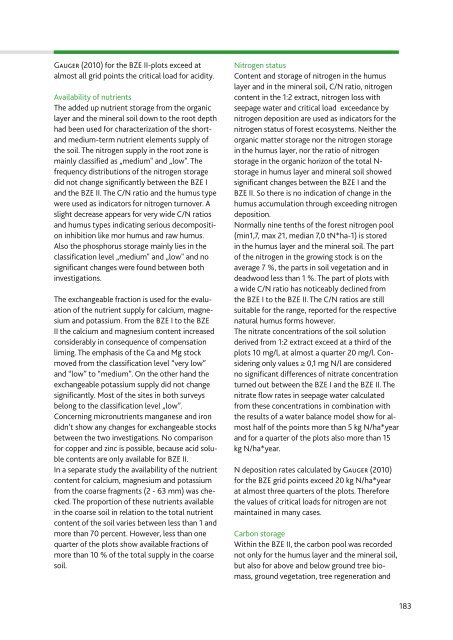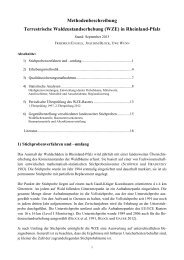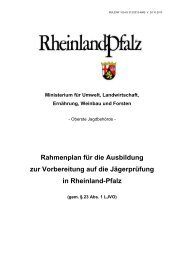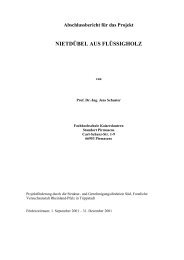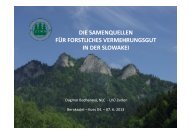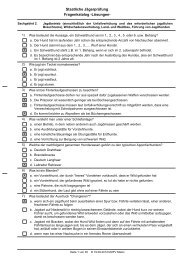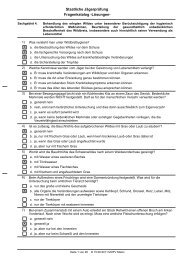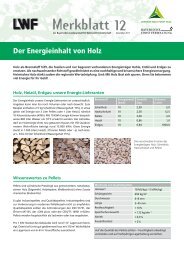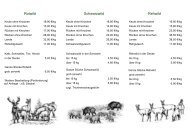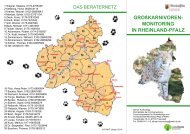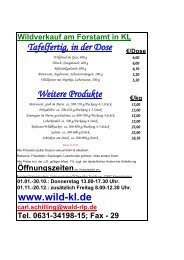Zentralstelle der Forstverwaltung - Landesforsten Rheinland-Pfalz
Zentralstelle der Forstverwaltung - Landesforsten Rheinland-Pfalz
Zentralstelle der Forstverwaltung - Landesforsten Rheinland-Pfalz
Sie wollen auch ein ePaper? Erhöhen Sie die Reichweite Ihrer Titel.
YUMPU macht aus Druck-PDFs automatisch weboptimierte ePaper, die Google liebt.
Gauger (2010) for the bze ii-plots exceed at<br />
almost all grid points the critical load for acidity.<br />
availability of nutrients<br />
the added up nutrient storage from the organic<br />
layer and the mineral soil down to the root depth<br />
had been used for characterization of the short-<br />
and medium-term nutrient elements supply of<br />
the soil. the nitrogen supply in the root zone is<br />
mainly classified as „medium" and „low". the<br />
frequency distributions of the nitrogen storage<br />
did not change significantly between the bze i<br />
and the bze ii. the C/n ratio and the humus type<br />
were used as indicators for nitrogen turnover. a<br />
slight decrease appears for very wide C/n ratios<br />
and humus types indicating serious decomposition<br />
inhibition like mor humus and raw humus.<br />
also the phosphorus storage mainly lies in the<br />
classification level „medium" and „low" and no<br />
significant changes were found between both<br />
investigations.<br />
the exchangeable fraction is used for the evaluation<br />
of the nutrient supply for calcium, magnesium<br />
and potassium. from the bze i to the bze<br />
ii the calcium and magnesium content increased<br />
consi<strong>der</strong>ably in consequence of compensation<br />
liming. the emphasis of the Ca and Mg stock<br />
moved from the classification level “very low”<br />
and “low” to “medium”. on the other hand the<br />
exchangeable potassium supply did not change<br />
significantly. Most of the sites in both surveys<br />
belong to the classification level „low”.<br />
Concerning micronutrients manganese and iron<br />
didn’t show any changes for exchangeable stocks<br />
between the two investigations. no comparison<br />
for copper and zinc is possible, because acid soluble<br />
contents are only available for bze ii.<br />
in a separate study the availability of the nutrient<br />
content for calcium, magnesium and potassium<br />
from the coarse fragments (2 - 63 mm) was checked.<br />
the proportion of these nutrients available<br />
in the coarse soil in relation to the total nutrient<br />
content of the soil varies between less than 1 and<br />
more than 70 percent. however, less than one<br />
quarter of the plots show available fractions of<br />
more than 10 % of the total supply in the coarse<br />
soil.<br />
nitrogen status<br />
Content and storage of nitrogen in the humus<br />
layer and in the mineral soil, C/n ratio, nitrogen<br />
content in the 1:2 extract, nitrogen loss with<br />
seepage water and critical load exceedance by<br />
nitrogen deposition are used as indicators for the<br />
nitrogen status of forest ecosystems. neither the<br />
organic matter storage nor the nitrogen storage<br />
in the humus layer, nor the ratio of nitrogen<br />
storage in the organic horizon of the total nstorage<br />
in humus layer and mineral soil showed<br />
significant changes between the bze i and the<br />
bze ii. so there is no indication of change in the<br />
humus accumulation through exceeding nitrogen<br />
deposition.<br />
normally nine tenths of the forest nitrogen pool<br />
(min1,7, max 21, median 7,0 tn*ha-1) is stored<br />
in the humus layer and the mineral soil. the part<br />
of the nitrogen in the growing stock is on the<br />
average 7 %, the parts in soil vegetation and in<br />
deadwood less than 1 %. the part of plots with<br />
a wide C/n ratio has noticeably declined from<br />
the bze i to the bze ii. the C/n ratios are still<br />
suitable for the range, reported for the respective<br />
natural humus forms however.<br />
the nitrate concentrations of the soil solution<br />
<strong>der</strong>ived from 1:2 extract exceed at a third of the<br />
plots 10 mg/l, at almost a quarter 20 mg/l. Consi<strong>der</strong>ing<br />
only values ≥ 0,1 mg n/l are consi<strong>der</strong>ed<br />
no significant differences of nitrate concentration<br />
turned out between the bze i and the bze ii. the<br />
nitrate flow rates in seepage water calculated<br />
from these concentrations in combination with<br />
the results of a water balance model show for almost<br />
half of the points more than 5 kg n/ha*year<br />
and for a quarter of the plots also more than 15<br />
kg n/ha*year.<br />
n deposition rates calculated by Gauger (2010)<br />
for the bze grid points exceed 20 kg n/ha*year<br />
at almost three quarters of the plots. therefore<br />
the values of critical loads for nitrogen are not<br />
maintained in many cases.<br />
Carbon storage<br />
Within the bze ii, the carbon pool was recorded<br />
not only for the humus layer and the mineral soil,<br />
but also for above and below ground tree biomass,<br />
ground vegetation, tree regeneration and<br />
183


